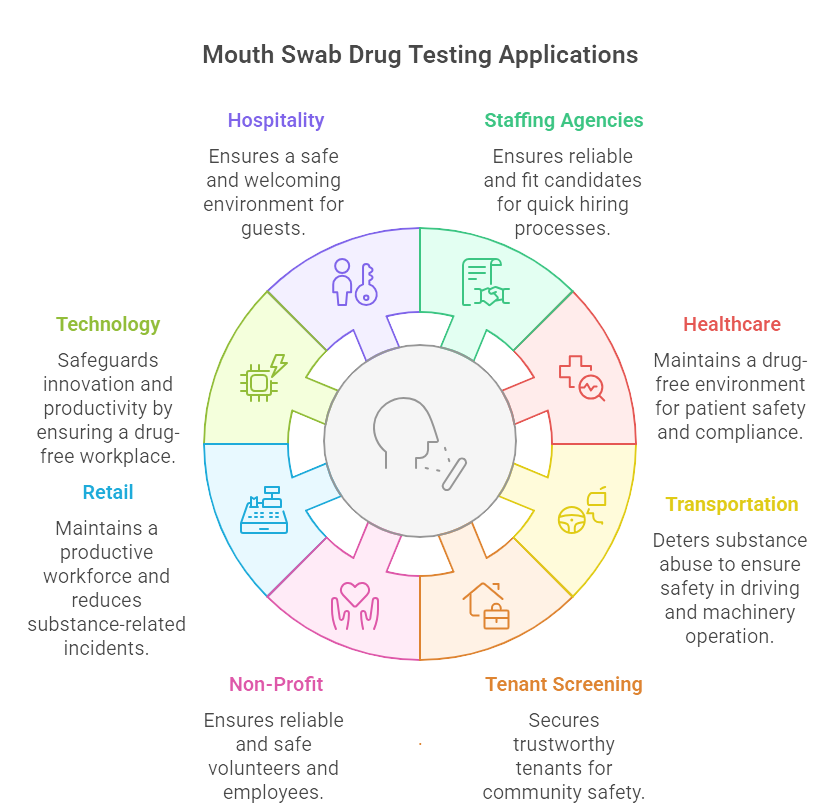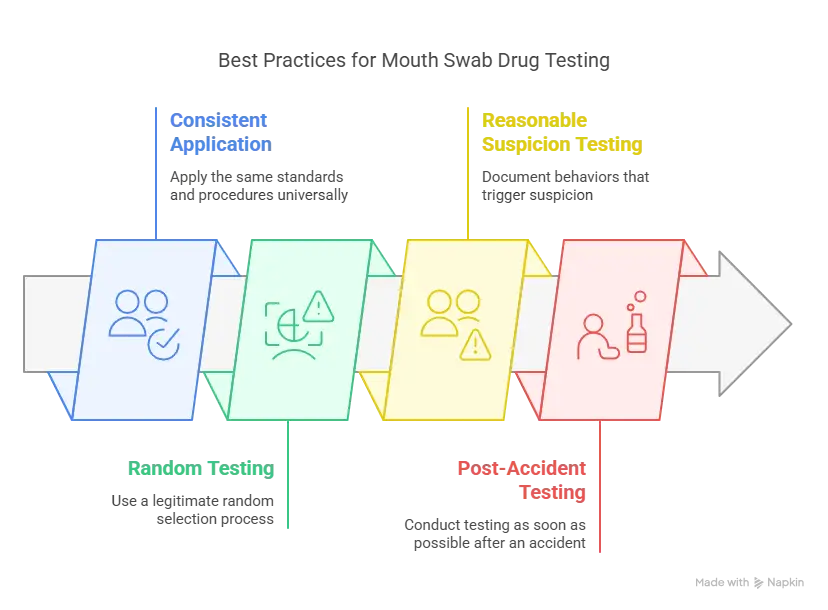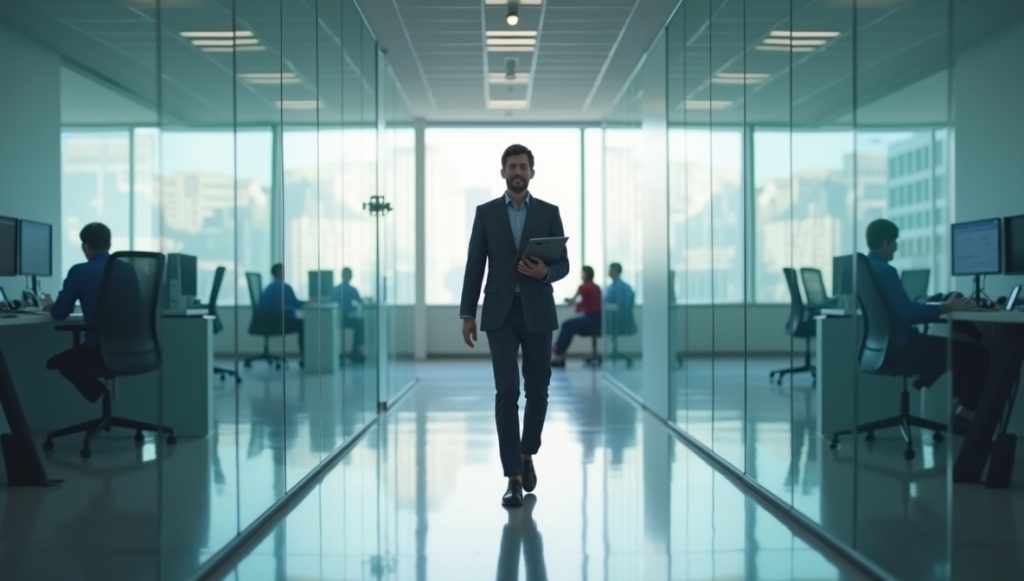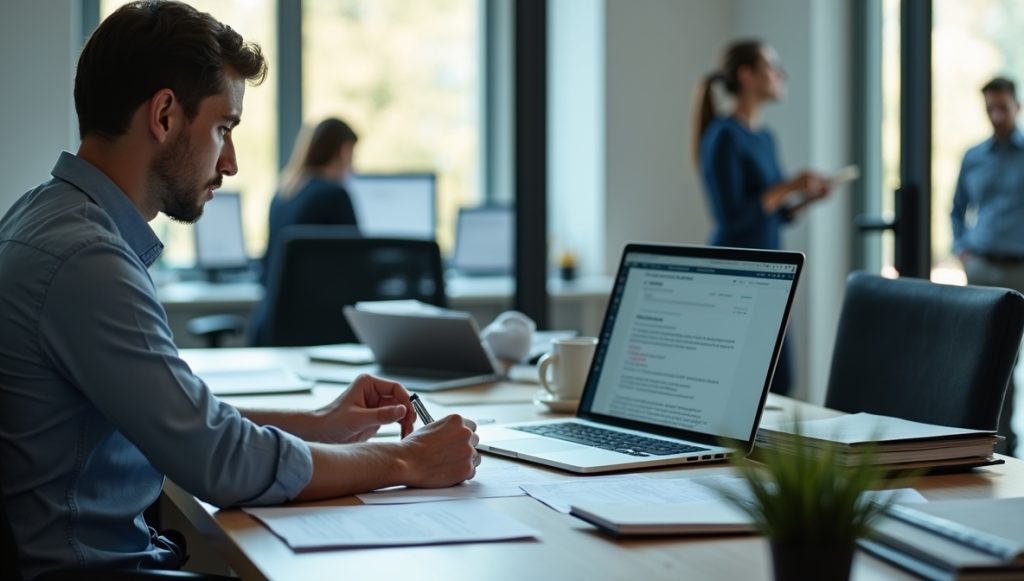Workplace drug testing has become increasingly important to maintain a safe, efficient, and compliant work environment. Among the various methods available, mouth swab drug testing is gaining popularity due to its non-invasive nature and practical application. This guide provides deep insights into mouth swab drug testing, how far back it can detect substance use, and the compliance considerations for various industries.
Key Takeaways
- Mouth swab drug testing is a non-invasive method that involves collecting a saliva sample to detect the presence of drugs.
- The procedure is quick and easy, often providing results in minutes, and is cost-effective compared to other testing methods.
- This type of drug testing is most effective at detecting recent drug use, typically within a 24 to 72-hour window.
- Various industries benefit from mouth swab testing to maintain safety and compliance, including healthcare, transportation, and retail.
- Adhering to best practices like consistent application, random testing, and post-accident testing ensures the fairness and reliability of mouth swab drug testing programs.
What is Mouth Swab Drug Testing?
Mouth swab drug testing, also known as oral fluid testing or saliva testing, involves collecting a saliva sample from an individual to detect the presence of drugs. It's a straightforward process that begins with the individual rubbing a swab along their gums and cheek. This swab absorbs saliva, which is then analyzed for traces of illicit substances.
The procedure is notably user-friendly and quick. An HR professional or a trained administrator hands over the swab, the individual uses it, and within a few minutes, the sample is ready for laboratory analysis or can be tested using on-site equipment for immediate results. This non-invasive and simple aspect makes mouth swab testing appealing for many workplaces.
The detection window varies by drug. Typically, mouth swab tests detect recent drug use, ranging from a few hours to up to 72 hours before the test. This shorter detection period often prompts the question, "How far back does a mouth swab drug screen go?" It's perfect for identifying recent use rather than long-term or historical substance consumption, providing a snapshot that's particularly useful for understanding immediate workplace safety.
EXPERT INSIGHT: I will never forget the day a mouth swab test demonstrated to us more than compliance—it initiated a discussion that changed a team member’s life. As an HR professional, we walk a delicate line each day between protecting the organization and advocating for the people that make it work. Mouth swab drug tests have given us a pragmatic yet empathetic way to provide safety without turning the workplace into a hub of enforcement. Quick, respectful, and wonderfully revealing—and not just in identifying current drug use, but perhaps more so in revealing our commitment to a culture of care. When done transparently and with compassion, it’s less policy and more people—and that’s where true workplace transformation begins. - Charm Paz, CHRP
Advantages of Mouth Swab Drug Testing
Mouth swab drug testing offers several practical benefits, making it an increasingly popular choice for employers across various industries.
Non-Invasive Nature
Unlike other drug testing methods, which can be uncomfortable or awkward, mouth swab tests are straightforward and non-invasive. Swabbing the inside of a person's cheek ensures minimal discomfort and can be done quickly without needing private facilities or specialized equipment.
Quick Results
Speed is often critical in workplace drug testing scenarios. Mouth swab tests deliver results rapidly—sometimes within minutes. This quick turnaround time allows employers to make timely decisions for pre-employment screening, post-incident analysis, or random checks.
Cost-Effective
Mouth swab drug testing is generally more cost-effective than blood or hair testing. The low-cost swabs and ease of administration reduce the need for expensive laboratory services, making it a financially viable option for businesses of all sizes.
Reduced Tampering
One significant advantage of mouth swab testing is its robustness against tampering. While urine tests can be tampered with using various methods, saliva samples are much more complex to alter or contaminate. This ensures that the integrity of the test remains intact, providing reliable results that employers can trust.
Mouth swab drug testing is a practical solution for maintaining workplace safety and compliance. It combines ease of use, rapid results, cost efficiency, and a high level of reliability.

How Far Back Does a Mouth Swab Drug Screen Go?
When discussing "how far back a mouth swab drug screen goes," it's essential to understand the detection window, which varies among different substances. Generally, mouth swab tests are most effective at detecting recent drug use, typically within a window of 24 to 48 hours. However, this window can extend up to 72 hours in some instances and for specific drugs.
Detection Timeline
- THC: Usually detectable for up to 24 hours after use, though chronic users may test positive for up to 72 hours.
- Cocaine: Detectable for about 24 to 48 hours post-use.
- Opiates: Generally found in saliva for up to 24 to 36 hours.
- Amphetamines and Methamphetamines: These can show up in a swab test from 24 to 48 hours after usage.
Factors Influencing Detection Window
Several factors can influence how long a substance is detectable in saliva:
- Frequency of Use: Regular users of certain substances may have longer detection windows than occasional users.
- Type of Drug: Different drugs metabolize at different rates, affecting how long they stay detectable in saliva.
- Individual Metabolism: Metabolic rate can vary from person to person. Faster metabolism can result in quicker clearance from the body.
Comparison with Other Methods
When comparing mouth swab testing with other drug testing methods:
- Urine Tests: These can typically detect substances for a more extended period, ranging from a few days up to a month, depending on the drug.
- Hair Tests: These offer the most extended detection window, often up to 90 days, since drugs can remain in hair follicles long after exiting other body parts.
Understanding the capabilities and limitations of mouth swab drug testing is crucial for implementing an effective and fair drug-free workplace policy. This method identifies recent use, making it suitable for post-accident or reasonable suspicion testing scenarios. Still, it may not be the best choice if the primary goal is to detect long-term substance use.
Implementation in Different Industries
Staffing Agencies
Staffing agencies play a crucial role in connecting businesses with potential employees. They must ensure that candidates are reliable and fit for the job, and drug testing is a crucial aspect of this vetting process. Mouth swab drug tests offer a quick and efficient way to screen numerous applicants without causing significant delays, making it a preferred choice in this fast-paced industry.
Healthcare
Compliance requirements in the healthcare sector are stringent, given the critical nature of the services provided. Implementing mouth swab drug testing helps maintain a drug-free environment, ensuring healthcare professionals are performing at their best and guaranteeing patient safety. Regular drug screenings help mitigate risks and align with legal and ethical standards in the healthcare industry.
Transportation
Safety is paramount in the transportation industry, where the consequences of impaired performance can be catastrophic. Mouth swab drug testing is an effective deterrent against substance abuse in roles involving driving or operating heavy machinery. These tests' quick results mean potential issues can be addressed promptly, maintaining the highest safety standards.
Tenant Screening
Drug testing in tenant screening processes can help landlords and property managers secure trustworthy tenants. A drug-free living environment is crucial for community safety and well-being. Mouth swab testing is a straightforward and unobtrusive method that fits well within comprehensive tenant screening protocols.
Non-Profit
Non-profits often work with vulnerable populations and rely heavily on volunteer and employee trustworthiness. Drug testing ensures that those representing the organization are reliable and safe. Mouth swab tests, with their ease of administration and quick turnaround, provide a pragmatic solution for non-profits aiming to maintain their integrity and mission.
Retail
Retail environments demand efficiency and a customer-centric focus. Drug testing in this sector can help maintain a productive workforce and reduce incidents related to substance abuse. Mouth swab testing is practical, allowing for minimal disruption to daily operations while ensuring employee fitness for duty.
Technology
The technology sector thrives on innovation and productivity. Ensuring a drug-free workplace is essential to maintaining high standards of performance and creativity. Mouth swab testing offers a non-intrusive way to monitor substance use, safeguarding the company’s intellectual capital and the overall health of its workforce.
Hospitality
Customer experience is at the core of the hospitality industry. Maintaining a professional and competent staff is non-negotiable. Drug testing through mouth swabs can help ensure employees are substance-free, contributing to a safe, welcoming, and enjoyable environment for guests. This testing method aligns well with the industry's emphasis on discretion and guest satisfaction.

HR Compliance Considerations
While effective, mouth swab drug testing necessitates careful navigation of the legal and ethical landscape. HR professionals must ensure drug testing practices align with legal requirements and uphold employee rights.
Legal Framework
Compliance with the relevant legal standards is the foundation of any drug testing policy. The Americans with Disabilities Act (ADA) and guidelines from the Equal Employment Opportunity Commission (EEOC) are pivotal. These regulations stipulate how drug testing should be conducted, especially to avoid discrimination and ensure that policies are applied uniformly. For a more comprehensive understanding, HR professionals are encouraged to refer directly to the EEOC's guidance, which outlines best practices and legal constraints.
Confidentiality
It is paramount to handle test results with the utmost confidentiality. Drug test results are sensitive personal information and must be treated as such to protect employee privacy. It is crucial to establish strict protocols for those who have access to these results and ensure that they are only used for their intended purpose. Breaching confidentiality can lead to legal ramifications and erode trust within the work environment.
Policy Development
Developing transparent and fair drug testing policies is essential. These policies should be comprehensive, detailing the circumstances under which testing will occur, the substances that will be tested for, and the consequences of a positive test. They must comply with federal and state laws, which vary significantly. Consistency in application is critical; policies should apply equally to all employees to avoid claims of discrimination or unfair treatment.
Training for Administrators
HR personnel and supervisors who administer mouth swab drug tests or handle the test results need proper training. Understanding the correct procedures for administering tests, recognizing the signs that may necessitate a test, and being aware of the legal and ethical implications are all vital. This training ensures the testing process is conducted smoothly, legally, and respectfully, minimizing errors and potential legal issues.
By adhering to these HR compliance considerations, employers can implement mouth swab drug testing in a manner that is legally sound, ethical, and respectful of employee rights. Proper compliance ensures that the testing serves its intended purpose of maintaining a safe and productive work environment without infringing on the legal protections afforded to employees.
Best Practices for Conducting Mouth Swab Drug Testing
Adhering to best practices is vital to ensuring the fairness, reliability, and legal compliance of mouth swab drug testing in the workplace. Implementing the following strategies can help employers conduct testing effectively:
Consistent Application
One of the most crucial aspects of drug testing is its consistent application across all employees. This means applying the same standards and procedures universally, irrespective of job position or level within the company. Inconsistent application can lead to discrimination claims and undermine the integrity of the testing program. Ensure that policies are documented and communicated to all staff, and make no exceptions to avoid any perceptions of bias or unfair treatment.
Random Testing
Random drug testing serves as a deterrent to substance use among employees. By making testing unannounced and unpredictable, employees are less likely to engage in drug use, knowing they could be tested at any time. Using a legitimate random selection process, such as a computer-generated algorithm, is essential to ensure fairness and avoid any claims of selective testing.
Reasonable Suspicion Testing
There are times when an employer might have reasonable suspicion that an employee is under the influence of drugs. This could be based on observable signs such as erratic behavior, poor performance, or noticeable physical symptoms. When implementing reasonable suspicion testing, it is essential to thoroughly document the behaviors that triggered the suspicion and ensure that supervisors are trained to recognize and report these signs correctly.
Post-Accident Testing
Conducting drug testing after a workplace accident can help determine whether substance use was a contributing factor. It's a critical step in investigating the cause of the accident and preventing future incidents. Post-accident testing should be done as soon as possible to ensure accurate results, preferably within a few hours of the incident. Employers must clearly define when post-accident testing is required in their policies and ensure all employees know this protocol.
These best practices aim to create a fair and legally compliant drug testing program. By integrating these strategies, employers can bolster the effectiveness of their mouth swab drug testing initiatives, ultimately contributing to a safer and more productive workplace.

Conclusion
To wrap up, mouth swab drug testing is noninvasive, cost-effective, and quick, ensuring workplace compliance and safety. It offers many advantages, from minimizing discomfort to reducing the likelihood of tampering with samples. The detection window varies by substance but generally covers recent use, making it a practical choice for employers looking to maintain a drug-free workplace.
For HR professionals and business owners, staying informed about mouth swab drug testing nuances is crucial. Implementing this method in different industries, from healthcare to technology, aligns with legal and safety requirements, promoting a secure and efficient work environment. It is also essential to follow best practices, such as developing clear policies, training administrators, and maintaining consistency in testing procedures.
Ultimately, mouth swab drug testing is not just about compliance—it's about fostering a safer, healthier, and more productive workplace. By making informed decisions and applying this method responsibly, employers can better ensure their employees' well-being and their organizations' success.
Additional Resources
- What a County Criminal Background Check Reveals About Your Candidates
- Does a Failed Pre-Employment Drug Test Go on Your Record?
- Understanding Mouth Swab Drug Testing for HR Compliance
- Ensuring Safe Hiring in the Hospitality Industry
- Beyond the Resume: Essential Background Checks for Nannies and Caregivers
- Conducting Screening in the Aviation Industry
- Improving the Screening Process
- Ensuring Safe Hiring in the Construction Industry
- Managing Screening Vendors Effectively
- Ensuring Data Accuracy in Employee Screening
- Enhancing Customer Service in Employee Screening
- Screening Seasonal Workers: Best Practices
- How Security Clearance Impacts Employment Opportunities
- Nebraska Background Check Laws: What HR Departments Need to Know
- Screening Practices for the Legal Sector
- Conducting Screening in the IT Industry
- An Overview of the Employee Screening Industry
- Screening for the Retail Industry
- Screening Practices in the Security Industry
- Understanding Employment Regulation
Still have questions?
Get in touch with our team today for a personalized demo and discover how our tailored volume pricing and packages can drive results for your business!
How useful was this page?*
Note: your comments are anonymous. We use them to improve the website. Do not include any personal details.
Visit our FCRA Compliance Tool or leave a message here if you need a response.
From the blog Explore the GCheck Content Hub

EEOC Compliance Requirements 2026: Complete Employer Guide to Fair Hiring Practices
29 Dec, 2025 • 24 min read
FCRA Compliance Guidelines 2026: Essential Requirements for Employers
29 Dec, 2025 • 26 min read
Ban the Box Laws 2026: Complete State Compliance Guide for Fair Chance Hiring
29 Dec, 2025 • 18 min readThe information provided in this article is for general informational and educational purposes only and should not be construed as legal advice or a substitute for consultation with qualified legal counsel. While we strive to ensure accuracy, employment screening laws and regulations—including but not limited to the Fair Credit Reporting Act (FCRA), Equal Employment Opportunity Commission (EEOC) guidelines, state and local ban-the-box laws, industry-specific requirements, and other applicable federal, state, and local statutes—are subject to frequent changes, varying interpretations, and jurisdiction-specific applications that may affect their implementation in your organization. Employers and screening decision-makers are solely responsible for ensuring their background check policies, procedures, and practices comply with all applicable laws and regulations relevant to their specific industry, location, and circumstances. We strongly recommend consulting with qualified employment law attorneys and compliance professionals before making hiring, tenant screening, or other decisions based on background check information.


